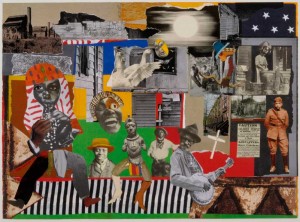The One Hundred Children of Romare Bearden
How does one celebrate the centennial of a great man – perhaps via a block party, a brass band, and a few hallelujahs thrown in for good measure? No doubt, Romare Bearden, a key figure of the Harlem Renaissance and arguably the most important African American painter and collage artist of the twentieth century, would have approved. But the Studio Museum in Harlem, an internationally recognized nexus for artists of African descent in New York City, has outdone the rest of his celebrants.
Through The Bearden Project, 100 artists have been invited to create new works of art inspired by the life and legacy of the man. Viewable till September 2, 2012, a revolving exhibit throughout the tri-state area will offer multiple ways for the public to engage with the art.
Bearden was an ardent supporter of the museum from its founding in 1968, nurturing the young talents that needed a home for their aspirations. An Artists-in-Residence program was conceived from the day the museum opened its doors in a rented loft at Fifth Avenue and 125th Street. Over 100 graduates of the program have gone on to distinguished careers, so it is only fitting that the spiritual progeny of Bearden honor him by calling on the same muse that obsessed him.
Abbe Schriber, a member of the museum’s curatorial team, was only too happy to show off some of the highlights from the 44 artists whose works have inaugurated this tribute.
“Bearden’s use of color, his use of composition, was very masterful,” she explained. “He was really interested in displaying African American life in a way that hadn’t been seen before.”
Bearden’s true genius lay in collage, so it is not surprising that John Outterbridge, one of the eldest “children” represented (and one who knew Bearden personally) created Godfather as homage to him. This is one of the most Bearden-esque pieces in the exhibit—a joyous, almost slap-dash evocation of the folk world of the Old South, so close to Bearden’s heart. African masks, crosses, and an elderly banjo player all intersect in unexpected ways. Kerry James Marshall’s Woman at the Window gives a stark, cubist-style mythic power to his female figure. Marshall, a Chicago artist, wrote that he liked the “controlled chaos” of collage. Myth also figures high in Dave McKenzie’s They Dreamed of Nefertiti’s Holiday, but with a lighter, more lyrical touch evident.
Njideka Akunyili, one of three young artists in residence at the museum for the 2011-12 year, is represented by Elulefu: The Lost One, a highly dramatic assemblage that combines photocopies of African dance clubs. Nigerian and Western culture collide with the depiction of an interracial couple in the foreground. In contrast, Derrick Adams’ Human Structure in a Self-Reflective State brings an elegant, almost melancholy tone to his collage.
But it is of little wonder if these sometimes socially combative, sometimes solitary figures; summon the complexity of Bearden the man. His was in a constant struggle between his singular, highly intelligent, artistic curiosity and the undeniable fact of his blackness. How to interpret that in the real world? After achieving considerable recognition, when he was eventually dropped from a major trendy New York gallery in 1949, it was a wrenching experience for the impeccably talented artist.
“Bearden was certainly the one who was working against the grain,” Schriber commented. “He was making realistic, figurative work when other things (minimalism, conceptual art) were happening.”
Bearden’s muse could be fickle and illusory. Combat in the U.S. Army had filled his eyes. Only in 1950 under a GI Bill, did he return briefly to Europe. It was then that those same eyes were filled with different sights—Cezanne, late Matisse cutouts, and Greek and African sculpture. What was he to do with these new images? Bearden’s answer: activism, and more importantly for him, collage.
(Article continued on next page)

